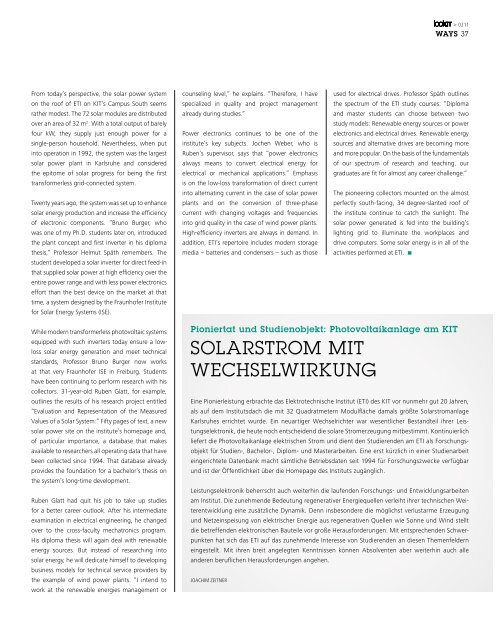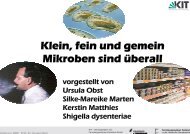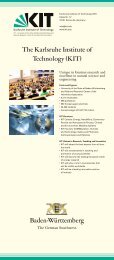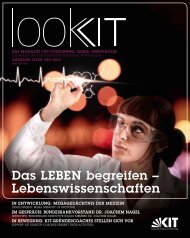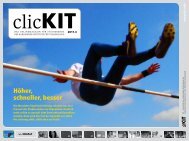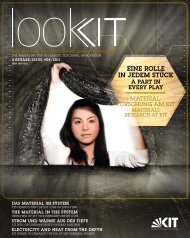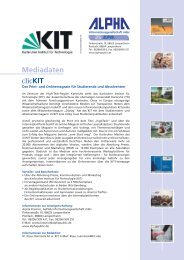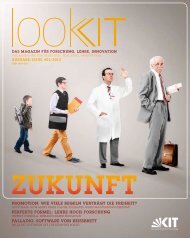lookKIT 02/2011 - PKM - KIT
lookKIT 02/2011 - PKM - KIT
lookKIT 02/2011 - PKM - KIT
Erfolgreiche ePaper selbst erstellen
Machen Sie aus Ihren PDF Publikationen ein blätterbares Flipbook mit unserer einzigartigen Google optimierten e-Paper Software.
<strong>02</strong>11<br />
Ways 37<br />
From today’s perspective, the solar power system<br />
on the roof of ETI on <strong>KIT</strong>’s Campus South seems<br />
rather modest. The 72 solar modules are distributed<br />
over an area of 32 m 2 . With a total output of barely<br />
four kW, they supply just enough power for a<br />
single-person household. Nevertheless, when put<br />
into operation in 1992, the system was the largest<br />
solar power plant in Karlsruhe and considered<br />
the epitome of solar progress for being the first<br />
transformerless grid-connected system.<br />
Twenty years ago, the system was set up to enhance<br />
solar energy production and increase the efficiency<br />
of electronic components. “Bruno Burger, who<br />
was one of my Ph.D. students later on, introduced<br />
the plant concept and first inverter in his diploma<br />
thesis,” Professor Helmut Späth remembers. The<br />
student developed a solar inverter for direct feed-in<br />
that supplied solar power at high efficiency over the<br />
entire power range and with less power electronics<br />
effort than the best device on the market at that<br />
time, a system designed by the Fraunhofer Institute<br />
for Solar Energy Systems (ISE).<br />
counseling level,” he explains. “Therefore, I have<br />
specialized in quality and project management<br />
already during studies.”<br />
Power electronics continues to be one of the<br />
institute’s key subjects. Jochen Weber, who is<br />
Ruben’s supervisor, says that “power electronics<br />
always means to convert electrical energy for<br />
electrical or mechanical applications.” Emphasis<br />
is on the low-loss transformation of direct current<br />
into alternating current in the case of solar power<br />
plants and on the conversion of three-phase<br />
current with changing voltages and frequencies<br />
into grid quality in the case of wind power plants.<br />
High-efficiency inverters are always in demand. In<br />
addition, ETI’s repertoire includes modern storage<br />
media – batteries and condensers – such as those<br />
used for electrical drives. Professor Späth outlines<br />
the spectrum of the ETI study courses: “Diploma<br />
and master students can choose between two<br />
study models: Renewable energy sources or power<br />
electronics and electrical drives. Renewable energy<br />
sources and alternative drives are becoming more<br />
and more popular. On the basis of the fundamentals<br />
of our spectrum of research and teaching, our<br />
graduates are fit for almost any career challenge.”<br />
The pioneering collectors mounted on the almost<br />
perfectly south-facing, 34 degree-slanted roof of<br />
the institute continue to catch the sunlight. The<br />
solar power generated is fed into the building’s<br />
lighting grid to illuminate the workplaces and<br />
drive computers. Some solar energy is in all of the<br />
activities performed at ETI.<br />
While modern transformerless photovoltaic systems<br />
equipped with such inverters today ensure a lowloss<br />
solar energy generation and meet technical<br />
standards, Professor Bruno Burger now works<br />
at that very Fraunhofer ISE in Freiburg. Students<br />
have been continuing to perform research with his<br />
collectors. 31-year-old Ruben Glatt, for example,<br />
outlines the results of his research project entitled<br />
“Evaluation and Representation of the Measured<br />
Values of a Solar System:” Fifty pages of text, a new<br />
solar power site on the institute’s homepage and,<br />
of particular importance, a database that makes<br />
available to researchers all operating data that have<br />
been collected since 1994. That database already<br />
provides the foundation for a bachelor’s thesis on<br />
the system’s long-time development.<br />
Ruben Glatt had quit his job to take up studies<br />
for a better career outlook. After his intermediate<br />
examination in electrical engineering, he changed<br />
over to the cross-faculty mechatronics program.<br />
His diploma thesis will again deal with renewable<br />
energy sources. But instead of researching into<br />
solar energy, he will dedicate himself to developing<br />
business models for technical service providers by<br />
the example of wind power plants. “I intend to<br />
work at the renewable energies management or<br />
Pioniertat und Studienobjekt: Photovoltaikanlage am <strong>KIT</strong><br />
Solarstrom mit<br />
Wechselwirkung<br />
Eine Pionierleistung erbrachte das Elektrotechnische Institut (ETI) des <strong>KIT</strong> vor nunmehr gut 20 Jahren,<br />
als auf dem Institutsdach die mit 32 Quadratmetern Modulfläche damals größte Solarstromanlage<br />
Karlsruhes errichtet wurde. Ein neuartiger Wechselrichter war wesentlicher Bestandteil ihrer Leistungselektronik,<br />
die heute noch entscheidend die solare Stromerzeugung mitbestimmt. Kontinuierlich<br />
liefert die Photovoltaikanlage elektrischen Strom und dient den Studierenden am ETI als Forschungsobjekt<br />
für Studien-, Bachelor-, Diplom- und Masterarbeiten. Eine erst kürzlich in einer Studienarbeit<br />
eingerichtete Datenbank macht sämtliche Betriebsdaten seit 1994 für Forschungszwecke verfügbar<br />
und ist der Öffentlichkeit über die Homepage des Instituts zugänglich.<br />
Leistungselektronik beherrscht auch weiterhin die laufenden Forschungs- und Entwicklungsarbeiten<br />
am Institut. Die zunehmende Bedeutung regenerativer Energiequellen verleiht ihrer technischen Weiterentwicklung<br />
eine zusätzliche Dynamik. Denn insbesondere die möglichst verlustarme Erzeugung<br />
und Netzeinspeisung von elektrischer Energie aus regenerativen Quellen wie Sonne und Wind stellt<br />
die betreffenden elektronischen Bauteile vor große Herausforderungen. Mit entsprechenden Schwerpunkten<br />
hat sich das ETI auf das zunehmende Interesse von Studierenden an diesen Themenfeldern<br />
eingestellt. Mit ihren breit angelegten Kenntnissen können Absolventen aber weiterhin auch alle<br />
anderen beruflichen Herausforderungen angehen.<br />
Joachim Zeitner


